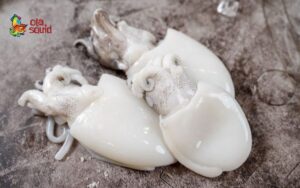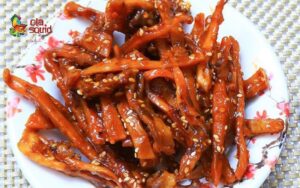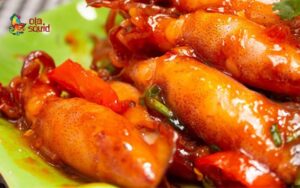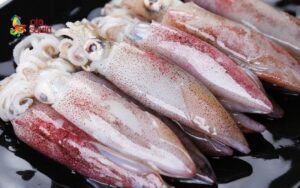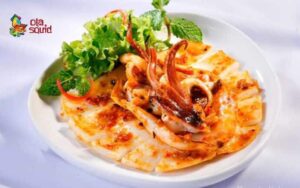Squid Noodle Soup is a rustic dish that carries the essence of the sea. Though not overly elaborate, it is refined enough to capture our taste buds. If you are looking for an authentic, easy-to-follow, yet truly satisfying recipe for bánh canh mực, join Ola Squid in exploring it in the article below!
Introduction to Squid Noodle Soup
Vietnamese cuisine always holds simple yet sophisticated treasures, and Squid Noodle Soup is a perfect testament to this. To fully appreciate the allure of this dish, let’s delve deeper into its ingredients and the unique characteristics of each steaming bowl of bánh canh mực.
What is Bánh Canh?
Bánh canh is a familiar traditional dish, popular across all regions of Vietnam. This dish uses noodles made from various flours such as rice flour, tapioca starch, or wheat flour. After thorough kneading, the dough is flattened and cut into thick, moderately sized strands.
The perfectly cooked bánh canh noodles are soft, slightly chewy, and not mushy. They are often blanched in boiling water before serving to maintain their tenderness and separate texture. This special texture allows the bánh canh noodles to readily “embrace” the broth, creating a harmonious whole that is captivating from sight to taste.
Characteristics of Bánh Canh Mực
While bánh canh cua is known for its richness, and bánh canh chả cá embodies the oceanic flavors of the Central region, bánh canh mực captivates diners with its natural sweet and delicate taste from fresh or dried squid.
The unique aspect of this dish lies in the sophisticated combination of a clear yet deeply savory broth, derived from bones and seafood, with the chewy, fragrant texture of squid – an ingredient that is not only rich in protein but also carries a distinct flavor of the sea.
Furthermore, some variations incorporate squid paste, shrimp, or mushrooms, making the bowl of bánh canh even more appealing, rich in both flavor and color. The ivory white of the noodles, accented by the reddish-orange of annatto oil, the golden hue of squid paste, and the fresh green of herbs, makes bánh canh mực not only delicious but also visually stunning.

Types of Squid Used in Bánh Canh
One of the elements that defines the soul of bánh canh mực is the selection of the right squid to suit the palate and cooking style. Depending on the region and preference, cooks can use the following types of squid:
- Squid (Mực ống): This is the most common type of squid used in this dish. Squid meat is thick, translucent white, sweet, fragrant, and ideally chewy. When cooked, the squid retains its firm texture and attractive color.
- Cuttlefish (Mực nang): Typically has a large body, thick flesh, and is less chewy than squid. When sliced and cooked in broth, cuttlefish offers a tender, easy-to-eat texture, very suitable for the elderly or young children.
- Squid Paste (Chả mực): This is a special choice for those who love the flavor of squid but want a richer dish. Squid paste is made from finely ground fresh squid, hand-pounded, and fried until golden. This paste has a natural chewiness and a sweet aroma. It is often served as a side dish or as an additional topping, especially in Quảng Ninh-style bánh canh mực variations.
Preparing Ingredients for Bánh Canh Mực
To make a perfectly flavored bowl of bánh canh mực, ingredient preparation is not just about processing them, but also about infusing your care and sophistication into the dish.
Bánh Canh Noodles
You can easily find pre-made bánh canh noodles at the market or supermarket. There are two common types: noodles made from rice flour (opaque white, soft, and fragrant) and noodles made from tapioca starch (translucent, slightly chewy).
However, if you have time, try making bánh canh noodles at home: it’s both safe and enjoyable. After kneading the dough and cutting it into strands, you should blanch the noodles quickly in boiling water for about 30 seconds, then immediately soak them in cold water. This little trick helps the noodles maintain their perfect chewiness, prevents them from becoming mushy when cooked, and makes the noodles fluffier and more appealing.
Fresh Squid
In bánh canh mực, choosing the right type of squid is key to elevating the dish. Depending on your preference and taste, you can use:
- Squid (Mực ống): Thick, crispy meat with a characteristic sweetness and an attractive translucent white color. Squid is very suitable for slicing into rings, helping to maintain its beautiful shape after cooking.
- Cuttlefish (Mực nang): Tender meat, easy to eat, less chewy, suitable for the elderly or children.
Regarding quantity, you should prepare about 300-400g of fresh squid for a serving of 3-4 people. Fresh, good-quality squid typically has a shiny body, bright color, and no strong fishy smell or sliminess. If possible, choose freshly caught squid to ensure the natural sweetness of the broth.

Topping Ingredients
Besides squid, bánh canh mực becomes much more appealing with the addition of various toppings, enhancing both flavor and nutrition:
- Pork Bones: About 500g of leg bones or tail bones for simmering the broth. This is the foundation that gives the broth its light sweetness, slight richness, and depth of flavor. Bones should be blanched briefly before simmering to remove any odor and impurities.
- Fresh Shrimp: Choose tiger prawns or whiteleg shrimp, peeled and deveined. Shrimp add a mild sweetness and a light seafood aroma to the dish.
- Mushrooms: You can use button mushrooms, fresh shiitake mushrooms, or enoki mushrooms. Mushrooms contribute a light, refreshing taste and create a harmonious flavor profile.
- Dried Squid: If you want a deeper, saltier flavor, add a few slices of rehydrated and thinly sliced dried squid. When lightly stir-fried and cooked in the broth, the dried squid will release a rich, characteristic sweetness, especially suitable for those who love traditional flavors.
- Seaweed (optional): An interesting accent for those who enjoy light and refreshing dishes. Seaweed not only adds a beautiful color but also provides a mild umami flavor, which pairs wonderfully with squid and shrimp.
Step-by-Step Guide to Cooking the Broth
This is the crucial part that determines whether the bánh canh mực broth will be authentic and as rich as you desire.
Simmer Bones for Sweet Broth
Take a large pot, add 500g of pork bones, and cover with water. Bring to a boil, skim off any foam, then rinse the bones with cold water. Add fresh water, sliced ginger, and grilled shallots, then simmer over low heat for about 1-1.5 hours to develop a rich broth.
Lightly Sauté Squid & Toppings
While the bones are simmering, heat a pan with oil. Add the fresh squid and sauté for 1-2 minutes. If using shrimp, sauté them until they turn pink. Add the dried squid and squid paste and stir-fry briefly to release their aroma. Lightly sautéing ensures the squid is cooked just right, retaining its chewiness and not becoming too soft or mushy.
Season & Strain the Broth
After the bones have softened and the aroma is released, strain the broth through a sieve to get a clear liquid. Add annatto oil to create a beautiful orange color. Adjust seasoning with salt, seasoning powder, and sugar. If you prefer a naturally sweet broth, reduce the amount of MSG and adjust to your taste. Any leftover broth can be cooled, strained thoroughly, divided into airtight containers, and stored in the refrigerator to be used within 2-3 days without losing its flavor.

Enjoying the Finished Dish
When everything is ready, from the sweet broth to the flavorful toppings, it’s time for the most exciting part: assembling and enjoying a steaming, fragrant bowl of bánh canh mực.
How to Assemble a Flavorful Bowl of Bánh Canh Mực
- Blanch the bánh canh noodles in boiling water for about 20-30 seconds to warm them up, making them soft and chewy without being mushy. Then, drain them and place them in a bowl.
- Arrange the toppings: Gradually layer fresh squid, dried squid, shrimp, squid paste, and mushrooms on top of the noodles. Each ingredient not only provides its own flavor but also makes the bowl more substantial and appealing.
- Ladle the hot broth over everything, allowing the steam to rise, releasing the aroma of squid, grilled onions, and simmered bones.
Finally, don’t forget to sprinkle with chopped green onions, cilantro, and ground pepper to enhance the dish’s fragrance and stimulate your appetite. If you enjoy sour and spicy flavors, you can add a few slices of fresh chili, some savory fish sauce, or a squeeze of lime juice to balance the flavors.
Each bite of chewy, sweet squid, each strand of soft bánh canh noodle, combined with the fragrant bone broth, creates an unforgettable culinary experience. Every spoonful of bánh canh mực is a journey for the taste buds: there’s the crispness of the squid, the richness of the bone broth, the lightness of mushrooms and shrimp, and the subtle, tingling heat from pepper and chili. A simple dish, yet it evokes memories and warmth, especially on rainy days or when you crave a comforting taste of home.

Other Delicious Variations of Bánh Canh
To keep bánh canh mực fresh and exciting, you can completely experiment with different ingredients and combinations. Each variation offers a unique character, reflecting the richness of seafood cuisine and the boundless creativity in Vietnamese kitchens.
Bánh Canh Mực Rong Biển (Squid and Seaweed Bánh Canh)
For those who love refreshing flavors, try adding thinly sliced seaweed to your bánh canh mực. Seaweed not only adds a visual accent but also imparts a distinct, mildly salty sea flavor. When hot broth is poured over, the seaweed softens just enough, retaining a slight crispness, and blends wonderfully with fresh squid, mushrooms, and chewy noodles.
This version is particularly suitable for summer days or meals that require a light yet nutritious option.
Bánh Canh Chả Mực Quảng Ninh (Quảng Ninh Squid Paste Bánh Canh)
Quảng Ninh squid paste has long been renowned for its delicious flavor, entirely handmade from fresh squid, pounded and fried until golden. When incorporated into bánh canh mực, the squid paste not only serves as a topping but also elevates the flavor of the entire dish.
With just a few slices of golden-fried squid paste, combined with the sweet broth from bones and squid, you will experience a sophisticated and rich harmony, full of Northern cultural essence.
Bánh Canh Tôm Mực Hỗn Hợp (Mixed Shrimp and Squid Bánh Canh)
If you want a more satisfying and appealing dish for gatherings or weekends, try the mixed shrimp and squid bánh canh – a confluence of three distinctive ingredients: fresh squid, tiger prawns, and squid paste.
Each component brings its own layer of flavor: the shrimp are delicately sweet and tender, the squid is delightfully chewy, and the squid paste is fragrant and slightly rich. When eaten, everything seems to melt into the warm broth, spreading a savory, sweet aftertaste throughout the palate. You can adjust the proportion of each topping according to your taste, but be sure to maintain balance so that every spoonful of bánh canh is a complete experience.

If you are captivated by bánh canh mực, don’t miss out on other squid dishes such as canh măng mực (bamboo shoot and squid soup) or khô mực nấu canh (dried squid for soup), each offering a completely new taste experience.
See more: How to cook delicious, rich, and authentic squid congee at home
Regional Eating Styles for Bánh Canh Mực
Every region of Vietnam has its own culinary preferences, and bánh canh mực thus carries many different nuances – from rich and vibrant to light and delicate.
Southern Specialties (Mekong Delta)
Southerners often enjoy rich flavors and the pleasant contrast between sour, sweet, and spicy. Southern-style bánh canh mực often includes tamarind water, rock sugar, and is served with spicy chili sauce. The broth is both rich and perfectly balanced, making the dish appealing and characteristic of the river region.
Central/Northern Regions
Conversely, the palates in the Central and Northern regions lean towards purity, focusing on preserving the natural sweetness of the squid and bones. Seasoning is moderate, not overly sweet or sour, just lightly enhanced with salt, pepper, and grilled onions. The dish is therefore light, with a clear squid flavor, easy to eat and memorable.
FAQ – Frequently Asked Questions
Here are some common questions you might encounter when cooking bánh canh mực for the first time:
Can squid paste be replaced with ground pork (giò sống)?
Yes, you can if you want to save time or change the flavor. Ground pork provides a chewy texture and a light richness, suitable for a sweet broth. However, the dish will lack the characteristic flavor of sea squid. If you want to maintain the authentic spirit of bánh canh mực, prioritize squid paste or fresh squid.
Does cooking bánh canh mực rong biển take a lot of time?
Not too much. The most time-consuming part is simmering the bones for the broth (about 1-1.5 hours). Seaweed only needs to be added in the last 5 minutes, not affecting the total cooking time. This is a suitable version for those who want a light and refreshing dish that still retains the flavor of the sea.
How long can bánh canh mực be stored in the refrigerator?
- Broth: Store in an airtight container in the refrigerator, consume within 2-3 days.
- Pre-prepared fresh squid: Should be used the same day, maximum 1 day in the refrigerator.
- Cooked toppings (shrimp, squid paste): Can be refrigerated for 1-2 days, but it’s best to consume them as soon as possible to ensure flavor and freshness.
We hope this article has guided you on how to cook bánh canh mực, from selecting ingredients, preparing them, to the steps of cooking the broth and how to enjoy it authentically. The exquisite harmony between the natural sweetness of squid, bones, and soft, chewy bánh canh noodles is sure to enchant anyone from the very first taste. We wish you success and delicious, fulfilling meals! If you have any questions or want to share your experiences, don’t hesitate to share them with Ola Squid.


 Tiếng Việt
Tiếng Việt ไทย
ไทย